Prion that causes mad cow disease. Prion Diseases: Causes, Symptoms, and Management of BSE and CJD
What are prion diseases. How do prions affect the brain. What are the main types of prion diseases. How are prion diseases diagnosed and treated. Can prion diseases be prevented.
Understanding Prion Diseases: A Comprehensive Overview
Prion diseases, also known as transmissible spongiform encephalopathies (TSEs), are a group of rare and fatal neurodegenerative disorders that affect both humans and animals. These diseases are caused by abnormally folded proteins called prions, which can trigger normal proteins in the brain to misfold and accumulate, leading to brain damage and a range of devastating symptoms.
Prion diseases are particularly intriguing due to their unique pathogenesis and the challenges they present in diagnosis and treatment. While relatively rare, with approximately 300 cases reported annually in the United States, their impact on affected individuals and families is profound.
The Nature of Prions
How do prions differ from other infectious agents? Unlike bacteria, viruses, or fungi, prions are misfolded proteins that can cause other normal proteins to misfold and accumulate in the brain. This process leads to brain damage and the characteristic symptoms of prion diseases.
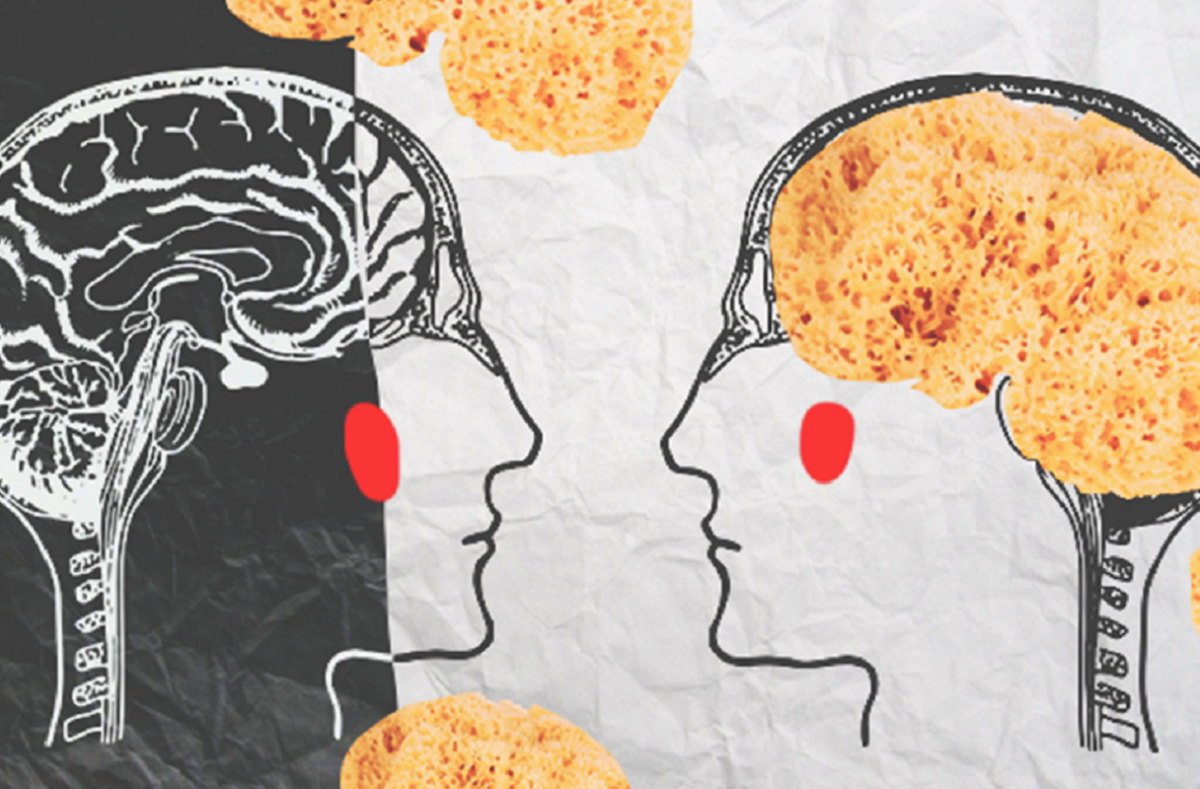
The prion protein (PrP) is found naturally on the surface of many cells in the body. In prion diseases, this protein becomes abnormally folded (PrPSc) and begins to accumulate in the brain, forming clumps that disrupt normal neuronal function.
Types of Prion Diseases: From CJD to Kuru
Prion diseases encompass several conditions, each with its unique characteristics and modes of transmission. Understanding these different types is crucial for proper diagnosis and management.
Creutzfeldt-Jakob Disease (CJD)
CJD is the most common prion disease affecting humans. It can be categorized into three main types:
- Sporadic CJD (sCJD): This form accounts for about 85% of all CJD cases and occurs spontaneously without any known risk factors. It typically affects individuals around 60 years of age.
- Familial CJD (fCJD): This inherited form is caused by mutations in the prion protein gene (PRNP).
- Acquired CJD: This rare form is transmitted through exposure to infected tissue, often during medical procedures such as corneal transplants or the use of contaminated surgical instruments.
Variant Creutzfeldt-Jakob Disease (vCJD)
vCJD is linked to bovine spongiform encephalopathy (BSE), commonly known as “mad cow disease.” It is believed to be transmitted to humans through the consumption of contaminated beef products. Unlike other forms of CJD, vCJD typically affects younger individuals.
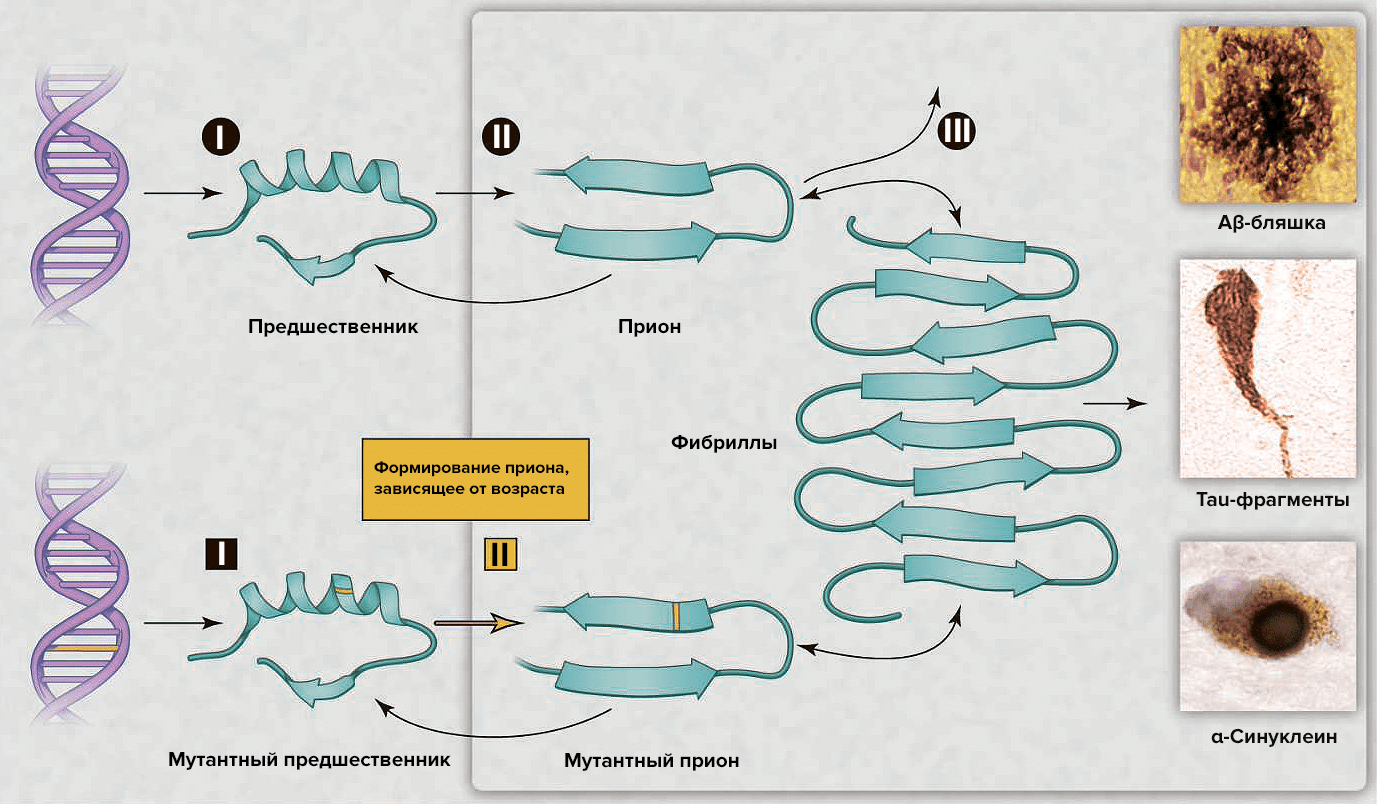
Other Prion Diseases
Several other prion diseases, though rarer, are important to recognize:
- Variably Protease-Sensitive Prionopathy (VPSPr): A recently identified prion disease that shares similarities with CJD but has distinct biochemical properties.
- Gerstmann-Sträussler-Scheinker Disease (GSS): An extremely rare inherited prion disease that typically manifests around age 40.
- Kuru: A prion disease historically found in Papua New Guinea, linked to ritualistic cannibalism practices.
- Fatal Insomnia (FI): A rare prion disease characterized by progressive insomnia and autonomic dysfunction. It can be inherited (Familial Fatal Insomnia) or occur sporadically.
The Pathogenesis of Prion Diseases: From Protein to Neurodegeneration
Understanding the mechanisms by which prions cause disease is crucial for developing effective treatments and preventive measures. The process of prion-induced neurodegeneration is complex and not fully understood, but several key steps have been identified.
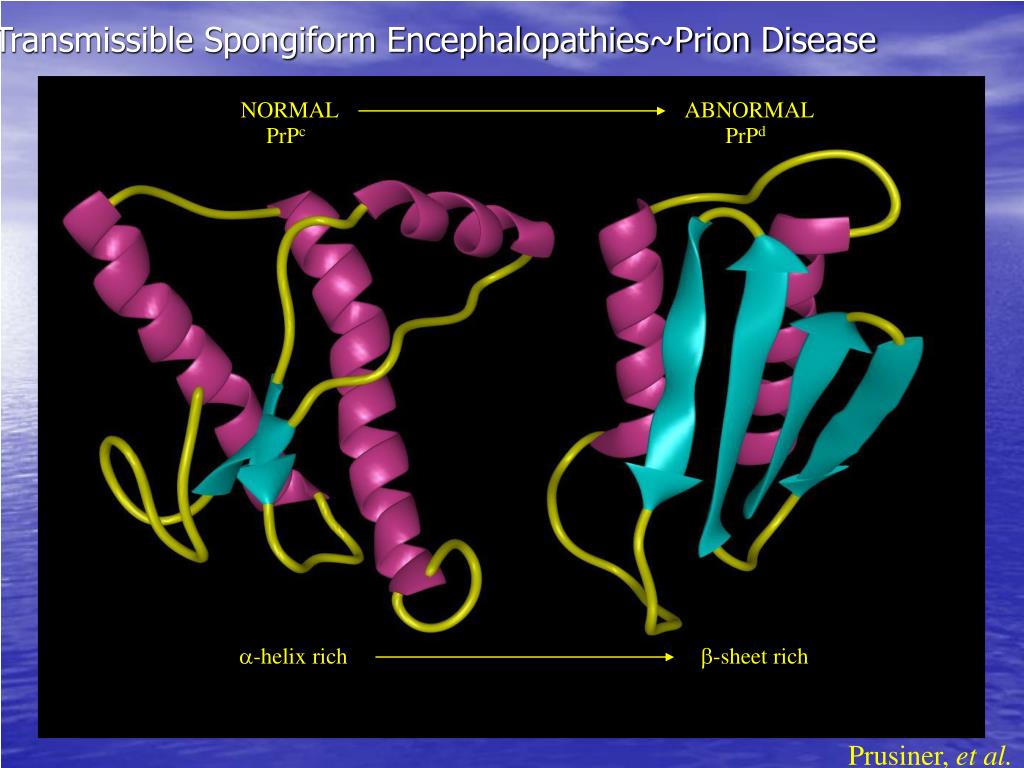
Prion Protein Misfolding
The central event in prion diseases is the misfolding of the normal prion protein (PrPC) into an abnormal, disease-causing form (PrPSc). This misfolded protein can then induce other normal prion proteins to misfold, creating a self-propagating cycle.
Aggregation and Neuronal Damage
As misfolded prions accumulate, they form aggregates that disrupt normal cellular function. These aggregates can interfere with synaptic transmission, damage neuronal membranes, and trigger inflammatory responses in the brain.
Spread Throughout the Brain
Prions can spread from neuron to neuron, gradually affecting larger areas of the brain. This spread correlates with the progressive nature of prion disease symptoms.
Recognizing the Signs: Symptoms of Prion Diseases
The symptoms of prion diseases can vary depending on the specific type and the areas of the brain affected. However, there are several common manifestations that healthcare providers should be aware of:
- Rapidly progressing dementia
- Ataxia (difficulty with coordination and balance)
- Myoclonus (involuntary muscle contractions)
- Visual disturbances
- Psychiatric symptoms (depression, anxiety, behavioral changes)
- Sleep disturbances
- Speech impairment
Why do prion diseases progress so rapidly? The self-propagating nature of prion misfolding and the lack of effective cellular mechanisms to clear these abnormal proteins contribute to the rapid progression of symptoms. Most individuals with CJD, for example, survive only about a year after symptom onset.
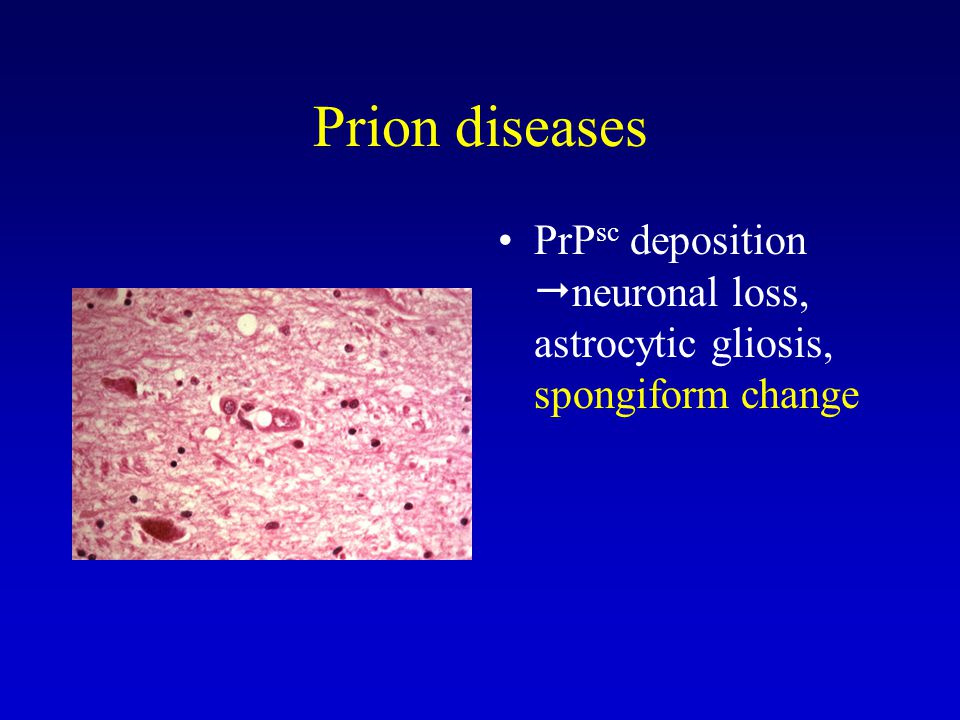
Diagnostic Challenges: Identifying Prion Diseases
Diagnosing prion diseases presents unique challenges due to their rarity and the similarity of their symptoms to other neurological conditions. A definitive diagnosis often requires a brain biopsy or post-mortem examination. However, several diagnostic tools can aid in the clinical diagnosis:
Neuroimaging
Magnetic Resonance Imaging (MRI) can reveal characteristic changes in the brain, such as cortical ribboning or basal ganglia hyperintensities in CJD.
Cerebrospinal Fluid Analysis
Elevated levels of certain proteins, such as 14-3-3 or tau, in the cerebrospinal fluid can support a diagnosis of CJD.
Electroencephalography (EEG)
EEG may show characteristic periodic sharp wave complexes in some cases of CJD.
Genetic Testing
For inherited forms of prion diseases, genetic testing can identify mutations in the PRNP gene.
RT-QuIC Assay
The Real-Time Quaking-Induced Conversion (RT-QuIC) assay is a highly sensitive and specific test for detecting the presence of abnormal prion proteins in cerebrospinal fluid or nasal brushings.

Treatment Approaches: Managing Prion Diseases
Currently, there are no cures for prion diseases, and treatment focuses on supportive care and symptom management. However, research into potential therapies is ongoing.
Supportive Care
The primary goal of treatment is to ensure the comfort and safety of the patient. This may include:
- Medications to manage symptoms such as myoclonus, seizures, or psychiatric disturbances
- Physical therapy to maintain mobility and prevent complications
- Nutritional support, often including feeding tubes in advanced stages
- Palliative care to manage pain and other distressing symptoms
Experimental Therapies
Several experimental approaches are being investigated for the treatment of prion diseases:
- Anti-prion compounds: Molecules designed to prevent or reverse prion protein misfolding
- Immunotherapies: Antibodies targeting abnormal prion proteins
- Gene therapies: Approaches to reduce the expression of the prion protein gene
- Stem cell therapies: Potential regenerative approaches to replace damaged neurons
Why have effective treatments for prion diseases been so elusive? The unique nature of prions, their ability to self-propagate, and the widespread brain damage that occurs before symptoms appear make developing treatments particularly challenging.

Prevention Strategies: Reducing the Risk of Prion Diseases
While some forms of prion diseases, such as sporadic CJD, cannot be prevented, there are measures that can reduce the risk of acquired prion diseases:
Food Safety
Stringent regulations on animal feed and meat processing have been implemented in many countries to prevent BSE and reduce the risk of vCJD. These include:
- Banning the use of ruminant-derived proteins in animal feed
- Strict surveillance and testing of cattle for BSE
- Removing specified risk materials (e.g., brain, spinal cord) from the food chain
Medical Procedures
To prevent iatrogenic transmission of prion diseases:
- Improved sterilization techniques for surgical instruments
- Screening of blood donors and restrictions on blood donation for individuals at risk
- Use of single-use instruments for certain procedures
Genetic Counseling
For families with a history of inherited prion diseases, genetic counseling and testing can help individuals make informed decisions about family planning.
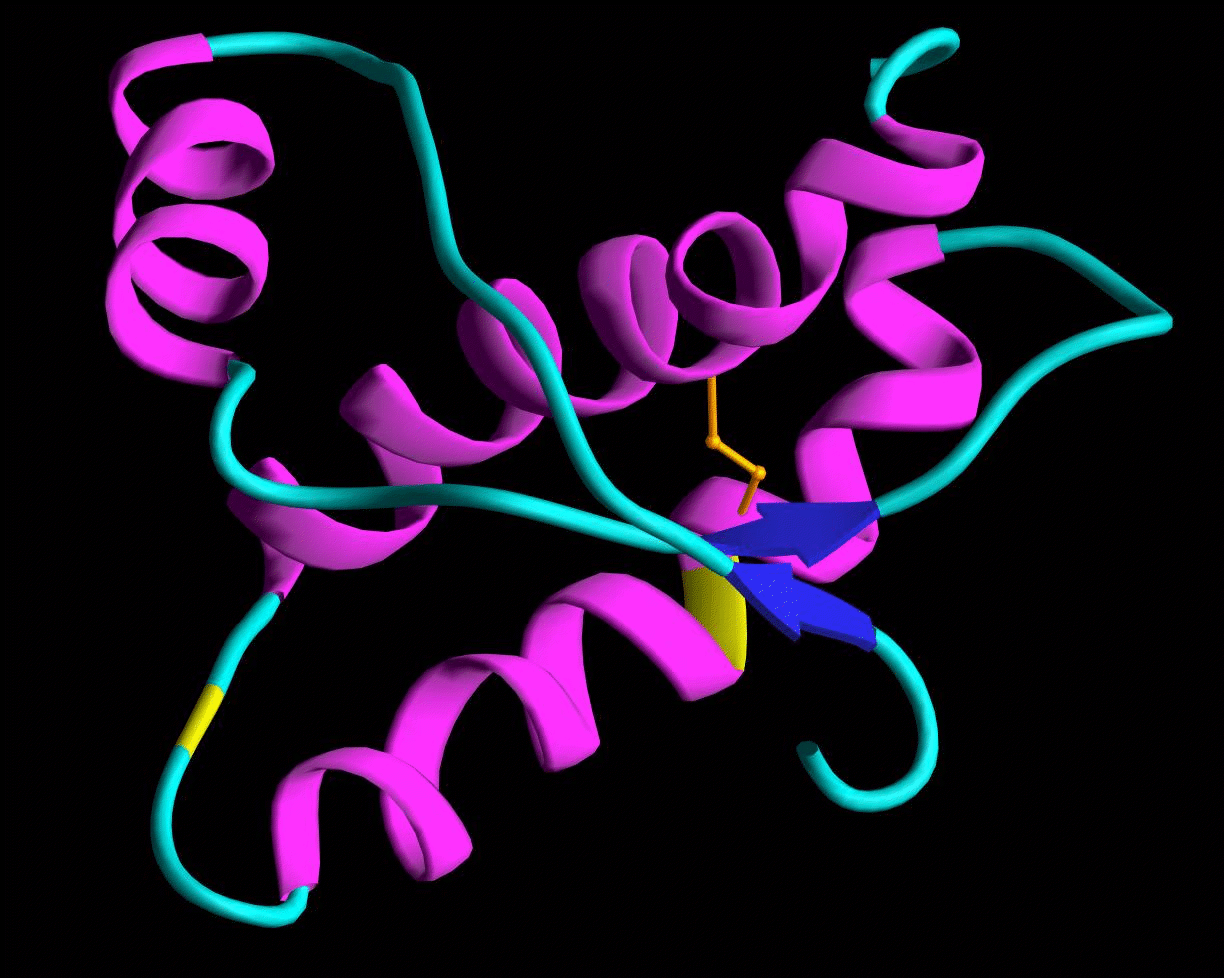
Living with Prion Diseases: Support and Care
The rapid progression and fatal nature of prion diseases make them particularly challenging for patients and their families. Comprehensive care and support are essential:
Multidisciplinary Care
A team approach involving neurologists, psychiatrists, palliative care specialists, and social workers can address the complex needs of patients with prion diseases.
Family Support
Counseling and support groups can help families cope with the emotional and practical challenges of caring for a loved one with a prion disease.
End-of-Life Care
As prion diseases are invariably fatal, discussions about end-of-life care and advance directives should be initiated early in the disease course.
How can healthcare providers best support patients and families affected by prion diseases? Open communication, compassionate care, and providing access to resources and support services are crucial elements in managing these devastating conditions.
Future Directions: Research and Hope in Prion Diseases
While prion diseases remain incurable, ongoing research offers hope for better understanding, diagnosis, and treatment of these conditions:
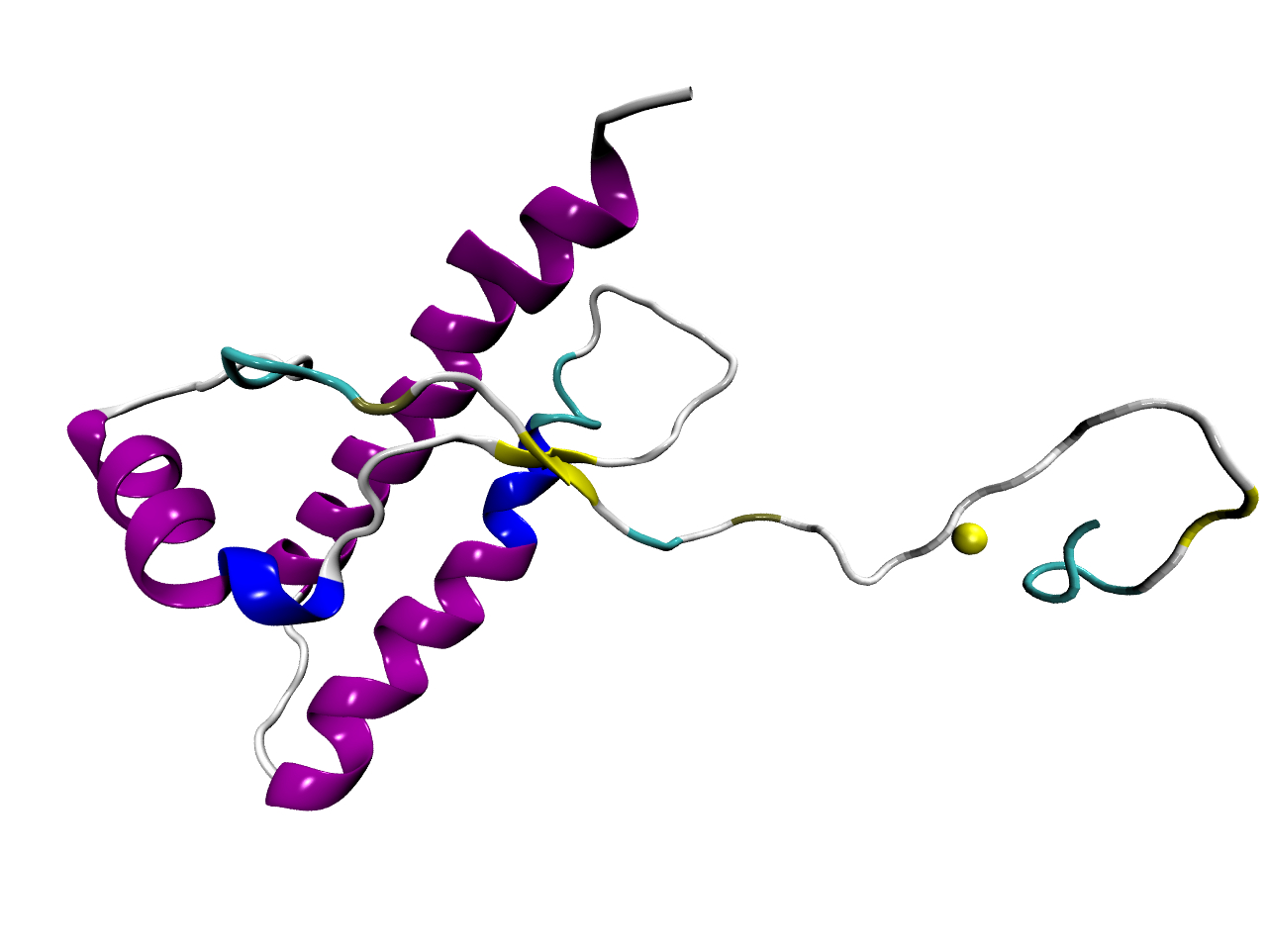
Early Detection
Developing more sensitive and specific diagnostic tests could allow for earlier intervention and potentially better outcomes.
Novel Therapeutic Approaches
Research into innovative treatment strategies, such as RNA interference, CRISPR gene editing, and targeted protein clearance, may lead to breakthroughs in prion disease therapy.
Understanding Prion Biology
Continued research into the fundamental mechanisms of prion propagation and neurodegeneration could reveal new therapeutic targets and prevention strategies.
One Health Approach
Recognizing the interconnectedness of human, animal, and environmental health in prion diseases emphasizes the importance of collaborative, interdisciplinary research efforts.
What role might artificial intelligence and machine learning play in advancing prion disease research? These technologies could potentially accelerate drug discovery, improve early detection algorithms, and enhance our understanding of prion protein misfolding dynamics.

In conclusion, while prion diseases remain among the most challenging neurological disorders to diagnose and treat, ongoing research and improved understanding offer hope for the future. As we continue to unravel the mysteries of these unique proteins, we move closer to developing effective strategies to combat these devastating conditions.
Prion Diseases | Johns Hopkins Medicine
Prion Diseases | Johns Hopkins Medicine
What are prion diseases?
Prion diseases comprise several conditions. A prion is a type of protein that can trigger normal proteins in the brain to fold abnormally. Prion diseases can affect both humans and animals and are sometimes spread to humans by infected meat products. The most common form of prion disease that affects humans is Creutzfeldt-Jakob disease (CJD).
Prion diseases are rare. About 300 cases are reported each year in the U.S.
Types of prion diseases include:
- CJD. A person can inherit this condition, in which case it’s called familial CJD. Sporadic CJD, on the other hand, develops suddenly without any known risk factors. Most cases of CJD are sporadic and tend to strike people around age 60.
 Acquired CJD is caused by exposure to infected tissue during a medical procedure, such as a cornea transplant. Symptoms of CJD (see below) quickly lead to severe disability and death. In most cases, death occurs within a year.
Acquired CJD is caused by exposure to infected tissue during a medical procedure, such as a cornea transplant. Symptoms of CJD (see below) quickly lead to severe disability and death. In most cases, death occurs within a year. - Variant CJD. This is an infectious type of the disease that is related to “mad cow disease.” Eating diseased meat may cause the disease in humans. The meat may cause normal human prion protein to develop abnormally. This type of the disease usually affects younger people.
- Variably protease-sensitive prionopathy (VPSPr). This is also extremely rare, it is similar to CJD but the protein is less sensitive to digestion. It is more likely to strike people around age 70 who have a family history of dementia.
- Gerstmann-Sträussler-Scheinker disease (GSS). Extremely rare, but occurs at an earlier age, typically around age 40.
- Kuru.
 This disease is seen in New Guinea. It’s caused by eating human brain tissue contaminated with infectious prions. Because of increased awareness about the disease and how it is transmitted, kuru is now rare.
This disease is seen in New Guinea. It’s caused by eating human brain tissue contaminated with infectious prions. Because of increased awareness about the disease and how it is transmitted, kuru is now rare. - Fatal insomnia (FI). Rare hereditary disorder causing difficulty sleeping. There is also a sporadic form of the disease that is not inherited.
What causes prion disease?
Prion diseases occur when normal prion protein, found on the surface of many cells, becomes abnormal and clump in the brain, causing brain damage. This abnormal accumulation of protein in the brain can cause memory impairment, personality changes, and difficulties with movement. Experts still don’t know a lot about prion diseases, but unfortunately, these disorders are generally fatal.
Who is at risk for prion diseases?
Risk factors for prion disease include:
- Family history of prion disease
- Eating meat infected by “mad cow disease”
- Infection from receiving contaminated corneas or from contaminated medical equipment
What are the symptoms of prion diseases?
Symptoms of prion diseases include:
- Rapidly developing dementia
- Difficulty walking and changes in gait
- Hallucinations
- Muscle stiffness
- Confusion
- Fatigue
- Difficulty speaking
How are prion diseases diagnosed?
Prion diseases are confirmed by taking a sample of brain tissue during a biopsy or after death. Healthcare providers, however, can do a number of tests before to help diagnose prion diseases such as CJD, or to rule out other diseases with similar symptoms. Prion diseases should be considered in all people with rapidly progressive dementia.
Healthcare providers, however, can do a number of tests before to help diagnose prion diseases such as CJD, or to rule out other diseases with similar symptoms. Prion diseases should be considered in all people with rapidly progressive dementia.
The tests include:
- MRI (magnetic resonance imaging) scans of the brain
- Samples of fluid from the spinal cord (spinal tap, also called lumbar puncture)
- Electroencephalogram, which analyzes brain waves; this painless test requires placing electrodes on the scalp
- Blood tests
- Neurologic and visual exams to check for nerve damage and vision loss
How are prion diseases treated?
Prion diseases can’t be cured, but certain medicines may help slow their progress. Medical management focuses on keeping people with these diseases as safe and comfortable as possible, despite progressive and debilitating symptoms.
Can prion diseases be prevented?
Properly cleaning and sterilizing medical equipment may prevent the spread of the disease. If you have or may have CJD, do not donate organs or tissue, including corneal tissue.
If you have or may have CJD, do not donate organs or tissue, including corneal tissue.
Newer regulations that govern the handling and feeding of cows may help prevent the spread of prion diseases.
Living with prion diseases
As prion diseases progress, people with these diseases generally need help taking care of themselves. In some cases they may be able to stay in their homes, but they eventually may need to move to a care facility.
Key points about prion diseases
- Prion diseases are very rare.
- Symptoms can progress rapidly requiring help with daily needs.
- Prion diseases are always fatal.
Next steps
Tips to help you get the most from a visit to your healthcare provider:
- Know the reason for your visit and what you want to happen.
- Before your visit, write down questions you want answered.
- Bring someone with you to help you ask questions and remember what your provider tells you.

- At the visit, write down the name of a new diagnosis, and any new medicines, treatments, or tests. Also write down any new instructions your provider gives you.
- Know why a new medicine or treatment is prescribed, and how it will help you. Also know what the side effects are.
- Ask if your condition can be treated in other ways.
- Know why a test or procedure is recommended and what the results could mean.
- Know what to expect if you do not take the medicine or have the test or procedure.
- If you have a follow-up appointment, write down the date, time, and purpose for that visit.
- Know how you can contact your provider if you have questions.
Related
-
Infectious DiseasesPolio (Poliomyelitis)
-
Brain, Nerves and SpineTypes of Muscular Dystrophy and Neuromuscular Diseases
-
Brain, Nerves and SpineTraumatic Brain Injury
Related Topics
Prion Diseases as Transmissible Zoonotic Diseases
1.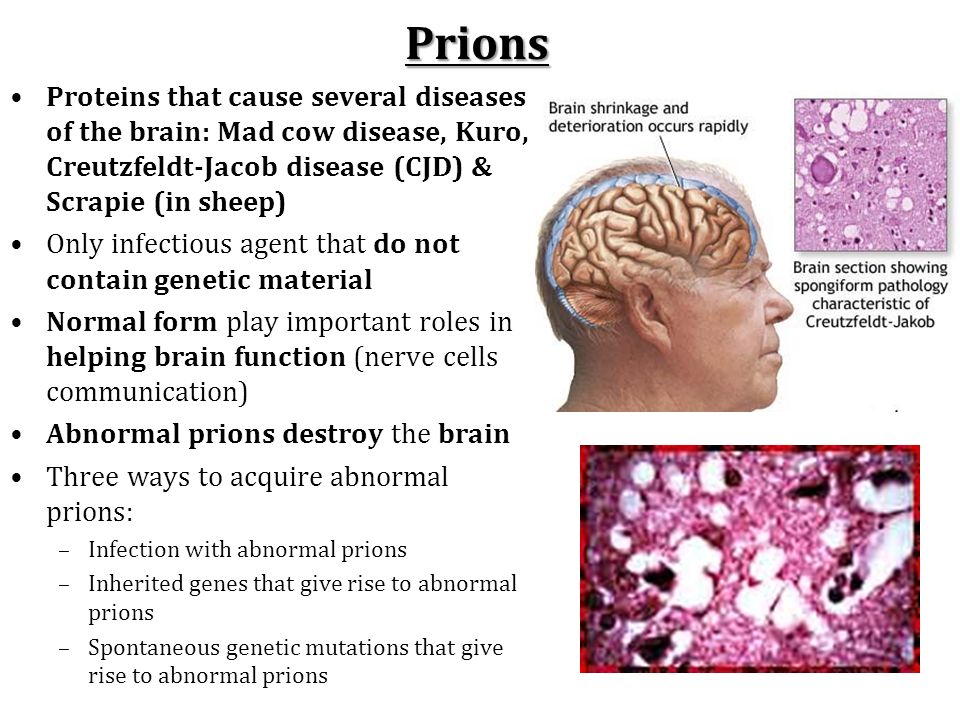 Prusiner SB. Prion biology and diseases. 2nd ed. Cold Spring Harbor, NY: Cold Spring Harbor Laboratory Press; 2004. [Google Scholar]
Prusiner SB. Prion biology and diseases. 2nd ed. Cold Spring Harbor, NY: Cold Spring Harbor Laboratory Press; 2004. [Google Scholar]
2. Jones KE, Patel NG, Levy MA, et al. Global trends in emerging infectious diseases. Nature. 2008 Feb;451(7181):990–3. [PMC free article] [PubMed] [Google Scholar]
3. Stark KD, Regula G, Hernandez J, et al. Concepts for risk-based surveillance in the field of veterinary medicine and veterinary public health: review of current approaches. BMC Health Serv Res. 2006;6:20. [PMC free article] [PubMed] [Google Scholar]
4. Prusiner SB. Molecular biology of prion diseases. Science. 1991 Jun;252(5012):1515–22. [PubMed] [Google Scholar]
5. Legname G, Baskakov IV, Nguyen HO, et al. Synthetic mammalian prions. Science. 2004 Jul;305(5684):673–6. [PubMed] [Google Scholar]
6. de Pedro-Cuesta J, Glatzel M, Almazan J, et al. Human transmissible spongiform encephalopathies in eleven countries: diagnostic pattern across time, 1993–2002. BMC Public Health. 2006;6:278. [PMC free article] [PubMed] [Google Scholar]
2006;6:278. [PMC free article] [PubMed] [Google Scholar]
7. Prusiner SB, DeArmond SJ. Prion diseases and neurodegeneration. Annu Rev Neurosci. 1994;17:311–39. [PubMed] [Google Scholar]
8. Steele AD, Lindquist S, Aguzzi A. The prion protein knockout mouse: a phenotype under challenge. Prion. 2007 Apr;1(2):83–93. [PMC free article] [PubMed] [Google Scholar]
9. Pezza JA, Serio TR. Prion propagation: the role of protein dynamics. Prion. 2007 Jan;1(1):36–43. [PMC free article] [PubMed] [Google Scholar]
10. Kovacs GG, Budka H. Molecular pathology of human prion diseases. Int J Mol Sci. 2009 Mar;10(3):976–99. [PMC free article] [PubMed] [Google Scholar]
11. Abid K, Soto C. The intriguing prion disorders. Cell Mol Life Sci. 2006 Oct;63(19–20):2342–51. [PMC free article] [PubMed] [Google Scholar]
12. Prusiner SB. Prions. Sci Am. 1984 Oct;251(4):50–9. [PubMed] [Google Scholar]
13. Prusiner SB. Novel proteinaceous infectious particles cause scrapie. Science. 1982 Apr;216(4542):136–44. [PubMed] [Google Scholar]
1982 Apr;216(4542):136–44. [PubMed] [Google Scholar]
14. Moore RA, Taubner LM, Priola SA. Prion protein misfolding and disease. Curr Opin Struct Biol. 2009 Feb;19(1):14–22. [PMC free article] [PubMed] [Google Scholar]
15. Liemann S, Glockshuber R. Transmissible spongiform encephalopathies. Biochem Biophys Res Commun. 1998 Sep;250(2):187–93. [PubMed] [Google Scholar]
16. Bremer J, Heikenwalder M, Haybaeck J, et al. Repetitive immunization enhances the susceptibility of mice to peripherally administered prions. PLoS One. 2009;4(9):e7160. [PMC free article] [PubMed] [Google Scholar]
17. Lloyd SE, Maytham EG, Pota H, et al. HECTD2 is associated with susceptibility to mouse and human prion disease. PLoS Genet. 2009 Feb;5(2):e1000383. [PMC free article] [PubMed] [Google Scholar]
18. Ryou C. Prions and prion diseases: fundamentals and mechanistic details. J Microbiol Biotechnol. 2007 Jul;17(7):1059–70. [PubMed] [Google Scholar]
19. Novakofski J, Brewer MS, Mateus-Pinilla N, Killefer J, McCusker RH. Prion biology relevant to bovine spongiform encephalopathy. J Anim Sci. 2005 Jun;83(6):1455–76. [PubMed] [Google Scholar]
Prion biology relevant to bovine spongiform encephalopathy. J Anim Sci. 2005 Jun;83(6):1455–76. [PubMed] [Google Scholar]
20. Prusiner SB. Detecting mad cow disease. Sci Am. 2004 Jul;291(1):86–93. [PubMed] [Google Scholar]
21. Bruederle CE, Hnasko RM, Kraemer T, et al. Prion infected meat-and-bone meal is still infectious after biodiesel production. PLoS One. 2008;3(8):e2969. [PMC free article] [PubMed] [Google Scholar]
22. Sutton JM, Dickinson J, Walker JT, Raven ND. Methods to minimize the risks of Creutzfeldt–Jakob disease transmission by surgical procedures: where to set the standard? Clin Infect Dis. 2006 Sep;43(6):757–64. [PubMed] [Google Scholar]
23. Gale P. BSE risk assessments in the UK: a risk tradeoff? J Appl Microbiol. 2006 Mar;100(3):417–27. [PubMed] [Google Scholar]
24. Wells GA, Konold T, Arnold ME, et al. Bovine spongiform encephalopathy: the effect of oral exposure dose on attack rate and incubation period in cattle. J Gen Virol. 2007 Apr;88(Pt 4):1363–73. [PubMed] [Google Scholar]
[PubMed] [Google Scholar]
25. Phillips NL, Bridgeman J, Ferguson-Smith MA. 2000. The BSE inquiry: return to an order of the Honourable House of Commons dated October 2000 for the report, evidence and supporting papers of the inquiry into the emergence and identification of bovine spongi-form encephalopathy (BSE) and variant Creutzfeldt–Jakob disease (vCJD) and the action taken in response to it up to 20 March 1996.
26. Lasmezas CI, Comoy E, Hawkins S, et al. Risk of oral infection with bovine spongiform encephalopathy agent in primates. Lancet. 2005 Feb-Mar;365(9461):781–3. [PubMed] [Google Scholar]
27. Aguzzi A. Unraveling prion strains with cell biology and organic chemistry. Proc Natl Acad Sci U S A. 2008 Jan;105(1):11–2. [PMC free article] [PubMed] [Google Scholar]
28. Beringue V, Vilotte JL, Laude H. Prion agent diversity and species barrier. Vet Res. 2008 Jul-Aug;39(4):47. [PubMed] [Google Scholar]
29. Kerstin Dressel AP, Ru Giuseppe, Van Wassenhove Wim. TSE roadmap—a comparative study of the risk perceptions and risk communications of stakeholders within European countries. Brussels, EC: Nov 23, 2009. The NeuroPrion Project. [Google Scholar]
TSE roadmap—a comparative study of the risk perceptions and risk communications of stakeholders within European countries. Brussels, EC: Nov 23, 2009. The NeuroPrion Project. [Google Scholar]
30. van Keulen LJ, Bossers A, van Zijderveld F. TSE pathogenesis in cattle and sheep. Vet Res. 2008 Jul-Aug;39(4):24. [PubMed] [Google Scholar]
31. TAFS . TAFS Position Paper on Specified Risk Materials. 2009. Swiss. [Google Scholar]
32. Foster JD, Parnham D, Chong A, Goldmann W, Hunter N. Clinical signs, histopathology and genetics of experimental transmission of BSE and natural scrapie to sheep and goats. Vet Rec. 2001 Feb;148(6):165–71. [PubMed] [Google Scholar]
33. Wilesmith JW, Ryan JB, Atkinson MJ. Bovine spongiform encephalopathy: epidemiological studies on the origin. Vet Rec. 1991 Mar;128(9):199–203. [PubMed] [Google Scholar]
34. Vaccari G, Panagiotidis CH, Acin C, et al. State-of-the-art review of goat TSE in the European Union, with special emphasis on PRNP genetics and epidemiology. Vet Res. 2009 Sep-Oct;40(5):48. [PMC free article] [PubMed] [Google Scholar]
Vet Res. 2009 Sep-Oct;40(5):48. [PMC free article] [PubMed] [Google Scholar]
35. Prusiner SB. Prions. Proc Natl Acad Sci U S A. 1998 Nov;95(23):13363–83. [PMC free article] [PubMed] [Google Scholar]
36. Miller MW, Williams ES. Prion disease: horizontal prion transmission in mule deer. Nature. 2003 Sep;425(6953):35–6. [PubMed] [Google Scholar]
37. Denkers ND, Seelig DM, Telling GC, Hoover EA. Aerosol and nasal transmission of chronic wasting disease in cervidized mice. J Gen Virol. 2010 Jun;91(Pt 6):1651–8. [PMC free article] [PubMed] [Google Scholar]
38. Public health issues related to animal and human spongiform encephalopathies: memorandum from a WHO meeting. Bull World Health Organ. 1992;70(2):183–90. [PMC free article] [PubMed] [Google Scholar]
39. Hope J, Reekie LJ, Hunter N, et al. Fibrils from brains of cows with new cattle disease contain scrapie-associated protein. Nature. 1988 Nov;336(6197):390–2. [PubMed] [Google Scholar]
40. Horiuchi M, Nakamitsu S. [Prion diseases in animals–bovine spongiform encephalopathy] Nippon Rinsho. 2007 Aug;65(8):1513–20. [PubMed] [Google Scholar]
[Prion diseases in animals–bovine spongiform encephalopathy] Nippon Rinsho. 2007 Aug;65(8):1513–20. [PubMed] [Google Scholar]
41. Wilesmith JW. Preliminary epidemiological analyses of the first 16 cases of BSE born after July 31, 1996, in Great Britain. Vet Rec. 2002 Oct;151(15):451–2. [PubMed] [Google Scholar]
42. Sapkota AR, Lefferts LY, McKenzie S, Walker P. What do we feed to food-production animals? A review of animal feed ingredients and their potential impacts on human health. Environ Health Perspect. 2007 May;115(5):663–70. [PMC free article] [PubMed] [Google Scholar]
43. Safar JG, Lessard P, Tamguney G, et al. Transmission and detection of prions in feces. J Infect Dis. 2008 Jul;198(1):81–9. [PMC free article] [PubMed] [Google Scholar]
44. Kruger D, Thomzig A, Lenz G, Kampf K, McBride P, Beekes M. Faecal shedding, alimentary clearance and intestinal spread of prions in hamsters fed with scrapie. Vet Res. 2009 Jan-Feb;40(1):4. [PMC free article] [PubMed] [Google Scholar]
45. Davies P, Brown DR. Manganese enhances prion protein survival in model soils and increases prion infectivity to cells. PLoS One. 2009;4(10):e7518. [PMC free article] [PubMed] [Google Scholar]
Davies P, Brown DR. Manganese enhances prion protein survival in model soils and increases prion infectivity to cells. PLoS One. 2009;4(10):e7518. [PMC free article] [PubMed] [Google Scholar]
46. Saunders SE, Bartelt-Hunt SL, Bartz JC. Prions in the environment: occurrence, fate and mitigation. Prion. 2008 Oct;2(4):162–9. [PMC free article] [PubMed] [Google Scholar]
47. Lombardi G, Casalone C, D’Angelo A, et al. Intraspecies transmission of BASE induces clinical dullness and amyotrophic changes. PLoS Pathog. 2008 May;4(5):e1000075. [PMC free article] [PubMed] [Google Scholar]
48. Capobianco R, Casalone C, Suardi S, et al. Conversion of the BASE prion strain into the BSE strain: the origin of BSE? PLoS Pathog. 2007 Mar;3(3):e31. [PMC free article] [PubMed] [Google Scholar]
49. Comoy EE, Casalone C, Lescoutra-Etchegaray N, et al. Atypical BSE (BASE) transmitted from asymptomatic aging cattle to a primate. PLoS One. 2008;3(8):e3017. [PMC free article] [PubMed] [Google Scholar]
50. Hörnlimann B, Riesner D, Kretzschmar HA. Prions in humans and animals. Berlin, New York: Walter de Gruyter; 2007. [Google Scholar]
Hörnlimann B, Riesner D, Kretzschmar HA. Prions in humans and animals. Berlin, New York: Walter de Gruyter; 2007. [Google Scholar]
51. Zeidler M, Stewart G, Cousens SN, Estibeiro K, Will RG. Codon 129 genotype and new variant CJD. Lancet. 1997 Aug 30;350(9078):668. [PubMed] [Google Scholar]
52. Bishop MT, Pennington C, Heath CA, Will RG, Knight RS. PRNP variation in UK sporadic and variant Creutzfeldt–Jakob disease highlights genetic risk factors and a novel non-synonymous polymorphism. BMC Med Genet. 2009;10:146. [PMC free article] [PubMed] [Google Scholar]
53. Collinge J, Whitfield J, McKintosh E, et al. A clinical study of kuru patients with long incubation periods at the end of the epidemic in Papua New Guinea. Philos Trans R Soc Lond B Biol Sci. 2008 Nov;363(1510):3725–39. [PMC free article] [PubMed] [Google Scholar]
54. Ponte ML. Insights into the management of emerging infections: regulating variant Creutzfeldt–Jakob disease transfusion risk in the UK and the US.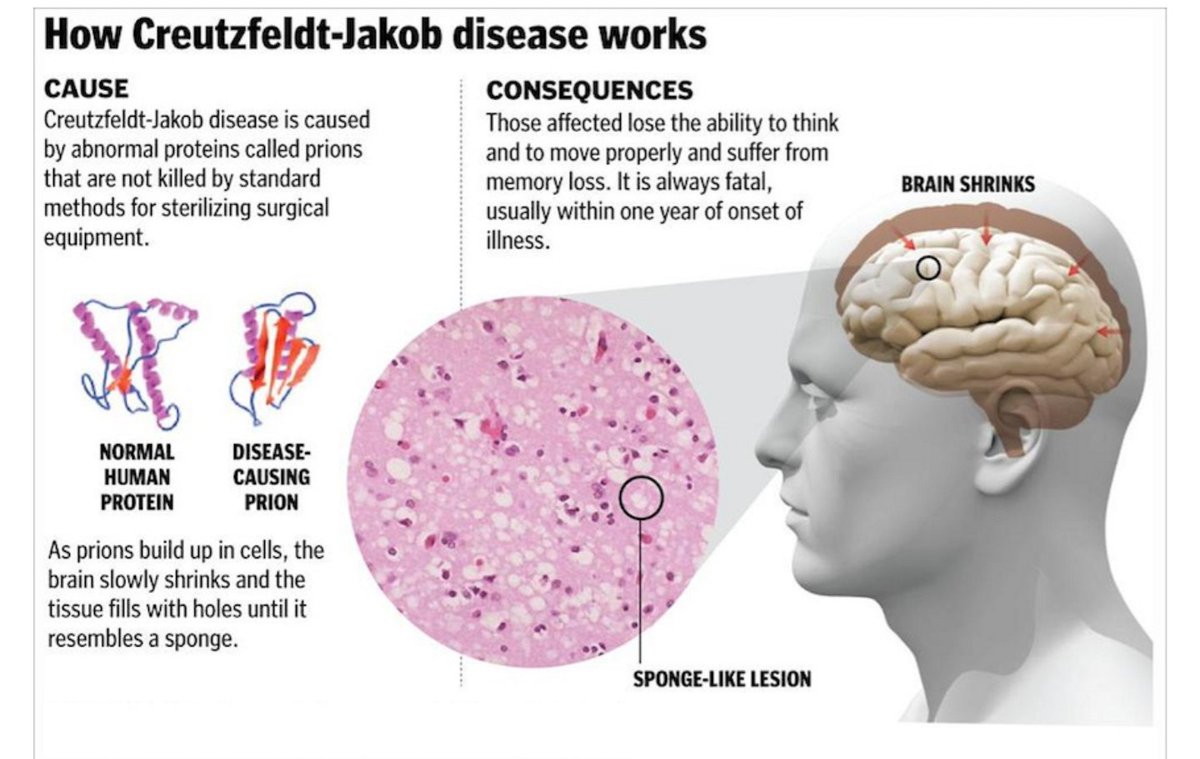 PLoS Med. 2006 Oct;3(10):e342. [PMC free article] [PubMed] [Google Scholar]
PLoS Med. 2006 Oct;3(10):e342. [PMC free article] [PubMed] [Google Scholar]
55. Bishop MT, Hart P, Aitchison L, et al. Predicting susceptibility and incubation time of human-to-human transmission of vCJD. Lancet Neurol. 2006 May;5(5):393–8. [PubMed] [Google Scholar]
56. Zeidler M, Johnstone EC, Bamber RW, et al. New variant Creutzfeldt–Jakob disease: psychiatric features. Lancet. 1997 Sep;350(9082):908–10. [PubMed] [Google Scholar]
57. Zeidler M, Stewart GE, Barraclough CR, et al. New variant Creutzfeldt–Jakob disease: neurological features and diagnostic tests. Lancet. 1997 Sep;350(9082):903–7. [PubMed] [Google Scholar]
58. Will RG, Ironside JW, Zeidler M, et al. A new variant of Creutzfeldt–Jakob disease in the UK. Lancet. 1996 Apr;347(9006):921–5. [PubMed] [Google Scholar]
59. Smith PG. The epidemics of bovine spongiform encephalopathy and variant Creutzfeldt–Jakob disease: current status and future prospects. Bull World Health Organ. 2003;81(2):123–30. [PMC free article] [PubMed] [Google Scholar]
[PMC free article] [PubMed] [Google Scholar]
60. Lefrere JJ, Hewitt P. From mad cows to sensible blood transfusion: the risk of prion transmission by labile blood components in the United Kingdom and in France. Transfusion. 2009 Apr;49(4):797–812. [PubMed] [Google Scholar]
61. Bourvis N, Boelle PY, Cesbron JY, Valleron AJ. Risk assessment of transmission of sporadic Creutzfeldt–Jakob disease in endodontic practice in absence of adequate prion inactivation. PLoS One. 2007;2(12):e1330. [PMC free article] [PubMed] [Google Scholar]
62. Bonetti D, Young L, Black I, Cassie H, Ramsay CR, Clarkson J. Can’t do it, won’t do it! Developing a theoretically framed intervention to encourage better decontamination practice in Scottish dental practices. Implement Sci. 2009;4:31. [PMC free article] [PubMed] [Google Scholar]
63. Gavier-Widen D, Stack MJ, Baron T, Balachandran A, Simmons M. Diagnosis of transmissible spongiform encephalopathies in animals: a review. J Vet Diagn Invest. 2005 Nov;17(6):509–27. [PubMed] [Google Scholar]
2005 Nov;17(6):509–27. [PubMed] [Google Scholar]
64. Soto C. Diagnosing prion diseases: needs, challenges and hopes. Nat Rev Microbiol. 2004 Oct;2(10):809–19. [PubMed] [Google Scholar]
65. Soto C, Saborio GP, Anderes L. Cyclic amplification of protein misfolding: application to prion-related disorders and beyond. Trends Neurosci. 2002 Aug;25(8):390–4. [PubMed] [Google Scholar]
66. Wilham JM, Orrú CD, Bessen RA, et al. Rapid end-point quantitation of prion seeding activity with sensitive comparable to bioassay. PLoS Pathog. 2010;6(12):e1001217. [PMC free article] [PubMed] [Google Scholar]
67. Gambetti P, Dong Z, Yuan J, et al. A novel human disease with abnormal prion protein sensitive to protease. Ann Neurol. 2008 Jun;63(6):697–708. [PMC free article] [PubMed] [Google Scholar]
68. Zou WQ, Gambetti P. Prion: the chameleon protein. Cell Mol Life Sci. 2007 Dec;64(24):3266–70. [PubMed] [Google Scholar]
69. Falsig J, Julius C, Margalith I, Schwarz P, Heppner FL, Aguzzi A. A versatile prion replication assay in organotypic brain slices. Nat Neurosci. 2008 Jan;11(1):109–17. [PMC free article] [PubMed] [Google Scholar]
A versatile prion replication assay in organotypic brain slices. Nat Neurosci. 2008 Jan;11(1):109–17. [PMC free article] [PubMed] [Google Scholar]
70. Wilson K, Code C, Dornan C, Ahmad N, Hebert P, Graham I. The reporting of theoretical health risks by the media: Canadian newspaper reporting of potential blood transmission of Creutzfeldt–Jakob disease. BMC Public Health. 2004 Jan;4:1. [PMC free article] [PubMed] [Google Scholar]
71. Chou WY, Hunt YM, Beckjord EB, Moser RP, Hesse BW. Social media use in the United States: implications for health communication. J Med Internet Res. 2009;11(4):e48. [PMC free article] [PubMed] [Google Scholar]
72. Hanney SR, Gonzalez-Block MA, Buxton MJ, Kogan M. The utilisation of health research in policy-making: concepts, examples and methods of assessment. Health Res Policy Syst. 2003 Jan;1(1):2. [PMC free article] [PubMed] [Google Scholar]
73. Holman RC, Belay ED, Christensen KY, et al. Human prion diseases in the United States. PLoS One. 2010;5(1):e8521. [PMC free article] [PubMed] [Google Scholar]
PLoS One. 2010;5(1):e8521. [PMC free article] [PubMed] [Google Scholar]
74. Giovannini A, Savini L, Conte A, Fiore GL. Comparison of BSE prevalence estimates from EU countries for the period July to December 2001 to the OIE and EU GBR classifications. J Vet Med B Infect Dis Vet Public Health. 2005 Aug;52(6):262–71. [PubMed] [Google Scholar]
75. Goossens B. Personal communication with Dr. Goossens, a Senior Scientific Officer of European Food Safety Authority. Prion 2009 Conference; Sep 23, 2009. [Google Scholar]
76. Marsh DR, Gilroy KE, Van de Weerdt R, Wansi E, Qazi S. Community case management of pneumonia: at a tipping point? Bull World Health Organ. 2008 May;86(5):381–9. [PMC free article] [PubMed] [Google Scholar]
77. Khumalo-Sakutukwa G, Morin SF, Fritz K, et al. Project Accept (HPTN 043): a community-based intervention to reduce HIV incidence in populations at risk for HIV in sub-Saharan Africa and Thailand. J Acquir Immune Defic Syndr. 2008 Dec;49(4):422–31. [PMC free article] [PubMed] [Google Scholar]
[PMC free article] [PubMed] [Google Scholar]
How mad cow disease destroys the brain
Scientists have come close to unraveling the mechanism of action of prion diseases. This is a whole group of neurodegenerative diseases that destroy the human brain, leaving no chance for salvation. Scientists hope that the discovery will bring them closer to developing a treatment.
Author:
medical editor Maria Sotskova
2
minutes
Those strange prions
Prions are special proteins with an abnormal structure that, like viruses, can infect mammals, including humans. They multiply in living cells, cause the body’s own proteins to turn into prions, especially often they affect the brain. It is the only known infection that replicates without RNA and DNA.
Prions are very stable, they accumulate from the affected tissues, damaging and destroying them. However, they are very difficult to chemically or physically destroy. Because of this, there is still no cure for any prion disease, they are all fatal in 100% of cases. Collectively, prion diseases are referred to as transmissible spongiform encephalopathies.
Because of this, there is still no cure for any prion disease, they are all fatal in 100% of cases. Collectively, prion diseases are referred to as transmissible spongiform encephalopathies.
Kuru is a neurodegenerative prion disease common among the aborigines of New Guinea. Basically, she dealt with cannibals who ate the brain of an enemy for ritual purposes. After the onset of the disease, the patient lives no more than a year, but the incubation period can last for decades.
Gerstmann-Straussler-Scheinker syndrome is rare. This is a hereditary disease that manifests itself in people from 20 to 60 years old. It starts with problems with coordination, and ends with deep dementia. The incubation period is from 5 to 30 years.
Fatal familial insomnia is perhaps one of the worst prion diseases. Patients literally lose the ability to sleep and die of insomnia within a few months.
 At this time, they are tormented by panic attacks and hallucinations.
At this time, they are tormented by panic attacks and hallucinations.Creutzfeldt-Jakob disease is also known as mad cow disease. Has several forms. The first – classical – occurs spontaneously in people over 50 years old, gradually destroys the brain, killing in 8 months. The second was called the “new version”, it appeared in the late 80s in the UK. Presumably, the first patients became infected from poorly processed meat from mad cows. There is an inherited form, and this disease can also be contracted, for example, during a medical intervention.
Prevent infection
Infecting the brain, prions accumulate in axons – long processes of neurons. As a result, they increase in size and lose their ability to conduct signals correctly. The development of other neurodegenerative diseases of a protein nature, for example, Alzheimer’s disease, proceeds in a similar way. If scientists manage to understand how and why this happens, then it will turn out, if not to rid people completely of these ailments, then at least learn to restrain them.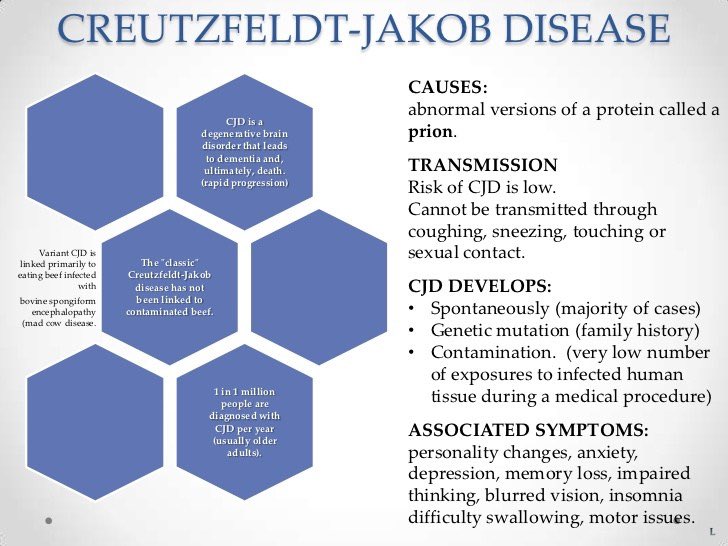
The researchers carefully observed the behavior of prions, proteins affect only axons, but do not touch the bodies of neurons themselves. It turned out that it was precisely in this feature that the solution lies. Usually, neurons are able to cleanse themselves of excess, including clumps of prions. However, things are more difficult with axons, the cells simply cannot cope with cleaning.
Apparently, neurons usually get rid of prions with the help of vesicles, small capsules that cells use to transport substances. Neurons send their vesicles along the microtubule systems to the axons, like on rails. If a prion is found in the capsule, then, once it enters the axon, it merges with others, forming aggregates, from which it is no longer possible to get rid of. As a result, these aggregates swell and block the paths for impulses, causing the rapid death of the neuron.
By understanding the mechanism, the scientists were able to counter it. They found four proteins that are responsible for sending prion vesicles into axons. When they suppressed the production of at least one of them, much fewer prions began to enter the axons. At the same time, neurons functioned normally or almost normally, and survived as well as healthy brain cells.
When they suppressed the production of at least one of them, much fewer prions began to enter the axons. At the same time, neurons functioned normally or almost normally, and survived as well as healthy brain cells.
Results obtained in mice so far. However, it causes optimism among researchers, they hope that the method will, if not cure diseases associated with the accumulation of proteins, then at least slow down their development.
“We are very enthusiastic about discovering molecules that can inhibit this pathway of aggregate formation and studying the effects of such inhibitors in animal models of prions and other neurodegenerative diseases,” said study co-author Sandra Encalada, Ph.D.
Comments CACKL E
Brain tissue impurities
Stylab offers test systems for determining impurities of head and bone marrow tissue in meat raw materials, ready-made food products, as well as in equipment, tools and on working surfaces.
| ||||||||||||
Prions can be transmitted from diseased carriers to healthy individuals with tissue particles. Since the PrP protein, the prion forms of which cause transmissible spongiform encephalopathies, is localized mainly in the cells of the central nervous system, the highest content of prions is found in the brain tissue. They are also found in the bone marrow, some parts of the intestines and tonsils.
Since the PrP protein, the prion forms of which cause transmissible spongiform encephalopathies, is localized mainly in the cells of the central nervous system, the highest content of prions is found in the brain tissue. They are also found in the bone marrow, some parts of the intestines and tonsils.
The greater the amount of prion ingested, the faster the disease will develop. However, even a small dose of a prion can cause it. For example, in Romney and Suffolk sheep, the minimum effective oral dose of a prion that causes transmissible bovine spongiform encephalopathy was 0.05 g. Animals usually receive prions from a diet containing bone meal made from the bones of diseased individuals.
The hypothesis of the existence of disease-causing prions was formulated in 1960s, and they themselves were isolated in the 1980s. However, prion diseases were known before. These include scrapie (sheep scabies) – a disease of sheep and goats, described in 1732, Creutzfeldt-Jakob disease (1920), kuru (1957), etc.
Some prions are dangerous for both animals and humans. Thus, the prion that causes “mad cow disease” in humans causes an atypical form of Creutzfeldt-Jakob disease (vCJD). There have been cases of prion transmission from person to person during rituals involving cannibalism. This is how the kuru disease, previously common among the natives of New Guinea, spreads. It is characterized by ataxia, headaches, convulsions and trembling. Patients usually die within a year after the onset of the first symptoms. Prions enter the human body with the tissues of sick animals, especially their brains.
Brains are category 1 by-products. They are used for the production of pates, as well as canned food for baby food. In addition, brain tissue and bone marrow can contaminate animal meat and fat during carcass cutting. Prions are not destroyed during food preparation. They withstand high temperatures, freezing and acids. To destroy them, exposure to strong alkalis or sodium hypochlorite, autoclaving with a gravitational method of air extraction and subsequent sterilization by conventional methods is necessary. Thus, any product containing brain tissue that has not been analyzed can theoretically become a source of prions.
Thus, any product containing brain tissue that has not been analyzed can theoretically become a source of prions.
Some cosmetics are made with animal ingredients. They may also contain prions if they come from sick individuals. Thus, cosmetics are potentially a pathway for the spread of prions if they are applied to the mucous membranes of the eyes or lips, or to damaged skin.
Following the mad cow disease epidemic in the 1990s, the European Union banned the use of animal tissue in animal feed and the use of tissue potentially containing prions, especially brain tissue, in the food industry. These measures, together with the isolation of animals and the slaughter of sick animals, have led to a significant reduction in mortality from “mad cow disease” among animals: in 2012, no more than 10 animals died from this cause worldwide. The decision to undertake them was due to the long incubation period and the danger of prion diseases.
To analyze the content of impurities in brain and bone marrow tissues in raw materials and finished products, as well as on instruments and work surfaces, it is convenient to use the ELISA method.

 This disease is seen in New Guinea. It’s caused by eating human brain tissue contaminated with infectious prions. Because of increased awareness about the disease and how it is transmitted, kuru is now rare.
This disease is seen in New Guinea. It’s caused by eating human brain tissue contaminated with infectious prions. Because of increased awareness about the disease and how it is transmitted, kuru is now rare.
 At this time, they are tormented by panic attacks and hallucinations.
At this time, they are tormented by panic attacks and hallucinations.